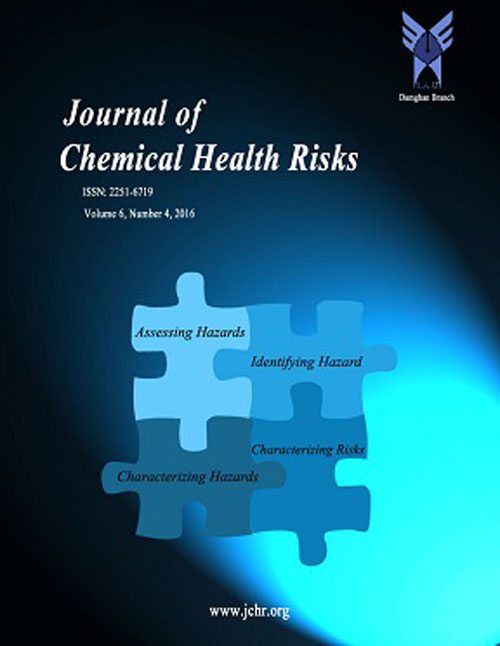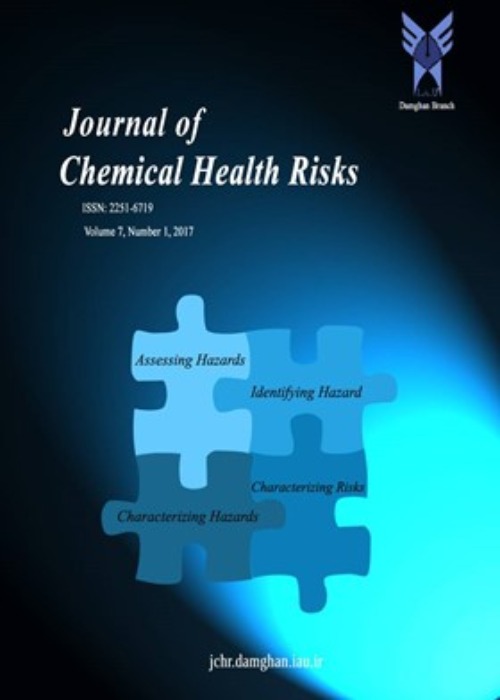فهرست مطالب

Journal of Chemical Health Risks
Volume:9 Issue: 1, Winter 2019
- تاریخ انتشار: 1398/01/19
- تعداد عناوین: 8
-
-
Pages 1-9The growth and development of human body is dependent on the protein, carbohydrate, vitamins and minerals. Fishes are one of the major sources of protein, vitamins and minerals for human. This study was conducted to know the effect of Mystus gulio fish fillet on growth performance of albino rats after feeding different concentrations of fish fillet as a protein source with formulated cereal for 32 days. Haematological and histopathological analysis were performed between control group and examined groups of albino rats. It was noticed that the body weight of each experimental albino rat was increasing gradually with increasing fish fillet up to 15% and beyond this the value was decreased. Moreover, the highest protein efficiency ratio (PER) and calorie efficiency ratio (CER) were observed 2.53% and 13.02% respectively for 15% supplied fish fillet. The gained in body weight (GBW) of albino rats in each experimental group depended mainly on supplied fish protein concentration but not on formulated cereal. According to hematological and histopathological studies, no toxicological effect was observed between control group and experimental groups of rats treated with different fish protein concentration for 32 consecutive days. Supplement of 15% fish fillet with formulated cereal was required to produce maximum nutritive values and the Mystus gulio could be considered as protein rich human diet.Keywords: Growth performance, Toxicological effect, Mystus gulio, Nona Tengra
-
Pages 11-25Childhood illnesses have been linked to elevated heavy metals in children’s bodies. Such studies are lacking in developing countries despite the fact that African children could be most exposed to heavy metals. This study determines the concentrations of heavy metals in blood and urine of children in selected schools within Owerri metropolis. Consent and due process were followed to obtain blood and urine samples from 60 children. Samples were digested with nitric and hydrochloric acids for 6 hours at 90o C and analyzed using Perkin Elmer 400 A analyst atomic absorption spectrometer. Mean concentrations in blood was Pb (4.517±1.599 mgl-1); Cd (1.04±0.671 mgl-1); Ni (5.612±1.237 mgl-1); Mn (7.198±4.705 mgl-1) and Cr (0.288 ±0.412 mgl-1). In urine; Pb (1.912±1.219 mgl-1); Cd (0.39±0.138 mgl-1); Ni (3.988±1.230 mgl-1); Mn (3.099±0.990 mgl-1) and Cr (20.773 ±10.449 mgl-1) were generally lower than concentrations in blood. Maximum metals concentrations in blood were higher than values for USA Academy of pediatrics. Except at WBP, Cr was highest concentrations within each school. Order of prevalence (%) was Pb> Ni > Cr >Mn> Cd in blood and Cd >Mn>Pb> Ni > Cr in urine. Variability revealed moderate to high with Cr (143%) as highest for blood while Pb (63.76%) was highest in urine. There was low relationship between metal in blood and urine as R2 values ranged between manganese (0.006) to nickel (0.216). The prominent trend of metal was Mn - Cr as highest and lowest concentrations respectively. Metal diagnostic ratios revealed very undesirable values for Cd (4.05) and Mn (3.545) in blood. Currently no standards for metals in blood and urine for African children, metal concentrations in the present study were elevated. Government agencies and policy makers need to act in time to reduce the potential danger in the near future.Keywords: Biomarker, Carcinogenic, Concentration, Environment, Diagnostic ratios, Toxicity, Trend
-
Pages 27-34Fishis one of the main sources of protein and important nutrients which help promote health. This study was an attempt to determine the impacts of using different levels of cassava leaves on antioxidant features, nutritional health values, and the quality of fish floss. Cut cassava leaves in different percentage (5%, 10% and 15%) were added to chili paste and tuna fish to prepare fish floss. The proximate analysis, antioxidant activities, color, and total cyanide content of the fish floss were then examined. The present findings suggest that the antioxidant activity of fish floss was likely to increase as there was an increase in the percentage addition of cassava leave compared with the control fish floss. The fiber content of fish floss increased by adding cassava leaves because cassava leaves are rich in fiber. Furthermore, cyanide content dropped to a lower level during pounding and boiling in water. It could be implied that cassava leaves with a lot of advantageous components could be a great ingredient to enhance antioxidant features and nutritional values (protein and fiber) of fish floss.Keywords: Fish floss, Cassava leaves, Antioxidant activities, Proximate analysis
-
Pages 35-47In the present study, trace amount of nickel (II) ions in real samples has been separated, preconcentrated and determined by a synthesized nanocomposite. Our suggested nanocomposite was prepared by immobilization of 2-aminopyrimidine on nanocellulose. The properties of nanocomposite were characterized by TEM, TGA, elementalanalysis CHNS, EDS, and BET techniques. The effective factors such as pH, nanocomposite amount, extraction time, eluent type, ionic strength and sample volume were optimized for quantitative determination of nickel (II) ions. The linear range of the calibration graph was between 5 and 500 ng mL−1 with limit of detection (LOD) 2.33 ng mL−1. Relative standard deviations (RSD) were 2.33%. Modified nanocellulose was used for measurement of the trace amounts of Ni (II) ions in the real samples such as human blood and urine with suitable fallouts.Keywords: Determination of nickel, Modified nanocellulose, 2-Aminopyrimidine
-
Pages 51-56Persimmon (Diospyros kaki) is an important subtropical, monoecious, dioeocious and polygamous tree which belongs to Ebenaceae family. Because of low total seed and low viability seed in persimmon, grafting on seedling rootstock is generally used for its propagation. The common rootstock is Diospyros lotus, but its seeds have long dormancy. So, the study was carried out to investigate the effects of stratification (0, 25, 50 and 70 days) at 4-70C, scarification with (97%) sulphuric acid (0, 2.5, 5 and7.5 minute) and GA3 (0, 250, 500 and 750 mgL-1) on seed germination of D. lotus. Results showed that the most germination rate was observed in GA3 at 250 mgL-1. Stratification for 70 days had the most germination percent. The most germination uniformity was observed in GA3 at 500 mgL-1. In scarification plus stratification, the germination percent was lower than control and stratification.Keywords: Germination, Stratification, Scarification, Diospyros lotus
-
Pages 57-67This study aimed to examine the relationship between pigments and seed fall rate of Iranian castor genotypes and genetic diversity, specifically 28 castor genotypes (27 native and 1 modified), a randomized complete block design with three replications was conducted in 2014 and 2015 at the Research Farm of Islamic Azad University in Damghan, northern Iran. During the growth period, the following traits were sampled: seed length; seed width; weight of 1,000 seeds; color of seed coat; number of leaves in the bush; leaf, nervure, and stem color; seed fall rate; growth type; seed performance; oil percentage; and chlorophyll fluorescence rate. After data collection, variance analysis was conducted through SAS and mean comparison was performed through Duncan test at 5% probability level. Correlation coefficients were calculated to find correlations, and cluster analysis was used to group the genotypes. Finally, graphs were drawn with Excel. The results indicated diversity in the investigated traits. Differences were observed among the native castor genotypes so that they were divided into five groups in terms of grain fall rate. A significant negative correlation at 1% probability level between the grain fall rate and the leaf color (r= –0.71**), nervure color (r= –0.56**), and stem color (r= –0.57**) indicated that in all of these three traits, when the color changed to dark red, the rate of grain loss decreased. Thus, the color trait can be used as a reference in breeding programs so that grain fall in the castor plant can be prevented in the future.Keywords: castor, Genotypic Diversity, Grain Fall, Color Combinations
-
Pages 69-74In this study, some chromens derivatives were synthesized as mentioned in our previous report.The synthesized compounds were evaluated for their antibacterial effect against three different bacterial species, using Disk Diffusion Agar test and microdilution broth (MIC) method against the S. aureus, E. coli, P. aeruginosabacterias according to the National Committee for Clinical Laboratory Standards (NCCLS) recommendations. The results indicated that 4-nitro compound has considerable antibacterial activity against S. aureusbacteria. Moreover, compound 3-chloro has antibacterial properties againstE. coli standard strain and none of 4H-Chromens derivatives have antibacterial effect on P. aeruginosa strains.Keywords: Antibacterial activity, 4H-Chromens deriva-tives, Microdilutionbroth, Disk Diffusion Agar test
-
Pages 75-86The potential of palm kernel shell, as agricultural waste, to remove Cr (VI) from aqueous solution was evaluated. Effective parameters such as pH (2–8), temperature (20–80 °C), contact time (10-120 min), adsorbent concentration (0.1–1 g/L), and initial Cr (VI) concentration (10-100 mg/L) were all studied to attain the maximum removal efficiency. Results show the adsorption capacity increases as pH value decreases and the optimum pH value is pH= 2.0. The other optimal conditions are temperature 40 °C, contact time 45 min, adsorbent concentration 0.5 g/L and initial Cr (VI) concentration 10 mg/L. The equilibrium data for chromate adsorption well fitted to Freundlich equation, with maximum adsorption capacity of 125 mg/g. This novel activated carbon derived from palm shell powder has been found to be effective for the removal of Cr (VI) and not noxious to the ecosystem.Keywords: Activated Carbon, Adsorption capacity, Chromium (VI), Freundlich isotherm, Palm Kernel Shell


